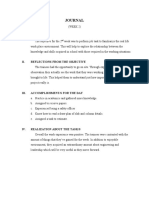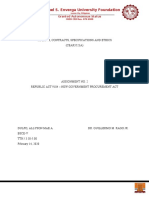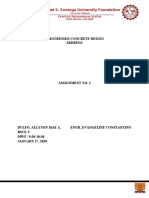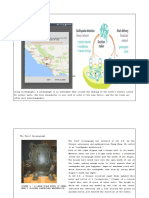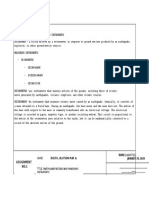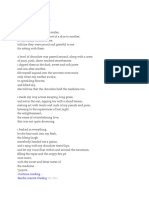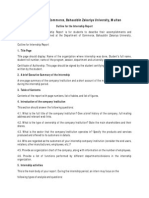0 ratings0% found this document useful (0 votes)
23 viewsPhysical Features and Natural Resources of South Asia
Physical Features and Natural Resources of South Asia
Uploaded by
Allyson DulfoSouth Asia is a region with vast diversity in its physical features and natural resources. It includes mountains, deserts, plains, plateaus, rainforests and tropical lands across its 1.73 million square kilometers. The major physical features include the Himalayan mountain range, the Indo-Gangetic plains, and rivers like the Indus, Ganges and Brahmaputra. Countries in the region rely on their natural resources and physical geography for their economies, including agriculture, fishing, mining, hydroelectric power and tourism. The physical environment and climate also influence the culture and shelter of the people living in South Asia.
Copyright:
© All Rights Reserved
Available Formats
Download as DOCX, PDF, TXT or read online from Scribd
Physical Features and Natural Resources of South Asia
Physical Features and Natural Resources of South Asia
Uploaded by
Allyson Dulfo0 ratings0% found this document useful (0 votes)
23 views3 pagesSouth Asia is a region with vast diversity in its physical features and natural resources. It includes mountains, deserts, plains, plateaus, rainforests and tropical lands across its 1.73 million square kilometers. The major physical features include the Himalayan mountain range, the Indo-Gangetic plains, and rivers like the Indus, Ganges and Brahmaputra. Countries in the region rely on their natural resources and physical geography for their economies, including agriculture, fishing, mining, hydroelectric power and tourism. The physical environment and climate also influence the culture and shelter of the people living in South Asia.
Original Description:
report
Copyright
© © All Rights Reserved
Available Formats
DOCX, PDF, TXT or read online from Scribd
Share this document
Did you find this document useful?
Is this content inappropriate?
South Asia is a region with vast diversity in its physical features and natural resources. It includes mountains, deserts, plains, plateaus, rainforests and tropical lands across its 1.73 million square kilometers. The major physical features include the Himalayan mountain range, the Indo-Gangetic plains, and rivers like the Indus, Ganges and Brahmaputra. Countries in the region rely on their natural resources and physical geography for their economies, including agriculture, fishing, mining, hydroelectric power and tourism. The physical environment and climate also influence the culture and shelter of the people living in South Asia.
Copyright:
© All Rights Reserved
Available Formats
Download as DOCX, PDF, TXT or read online from Scribd
Download as docx, pdf, or txt
0 ratings0% found this document useful (0 votes)
23 views3 pagesPhysical Features and Natural Resources of South Asia
Physical Features and Natural Resources of South Asia
Uploaded by
Allyson DulfoSouth Asia is a region with vast diversity in its physical features and natural resources. It includes mountains, deserts, plains, plateaus, rainforests and tropical lands across its 1.73 million square kilometers. The major physical features include the Himalayan mountain range, the Indo-Gangetic plains, and rivers like the Indus, Ganges and Brahmaputra. Countries in the region rely on their natural resources and physical geography for their economies, including agriculture, fishing, mining, hydroelectric power and tourism. The physical environment and climate also influence the culture and shelter of the people living in South Asia.
Copyright:
© All Rights Reserved
Available Formats
Download as DOCX, PDF, TXT or read online from Scribd
Download as docx, pdf, or txt
You are on page 1of 3
PHYSICAL FEATURES AND NATURAL RESOURCES OF SOUTH ASIA
South Asia is an area of vast diversity, from mountains to deserts, plains to plateaus rainforest
lands and tropical lands.
The region occupies 1.73 million sq. m. of the asian continent.
INDIA
The mountain ranges of the Hindu Kush and the Himalayas.
The Great Indo-Gangetic plains.
The Indus, Ganges , and Brahmaputra.
Fertile plain is a farming region thet makes it the Heartland of India
Southward of the subcontinent is the Indian peninsula with Deccan plateau.
Rivers water the eastern and southern plains through the Bay of Bengal.
A valuable scouce of teak and sandalwood.
India’s mammals have grown scarcer.
Supply of iron, coal, and hydroelectric power.
PAKISTAN
Southwestern Baluchistan plateau.
Townlands of India
River and its tributaries.
Support the farmlands.
Bangladesh’s
“Golden Fibre”
Second most important fibre
Jute
Lifeline of Bangladesh
Tropical climate
Mangrove forest, Village groves
Mango, bananas, coconut, and jackfruit, oil, peat, natural gas, coal, and limestone
Mineral resources
NEPAL
Himalayan mountain
World’s highest peak – Mt. Everest
Swampy places
Deciduous forests
SRI LANKA
Largely flat and rolling
100 rivers
Rice and tea
Fruits, vegetables, cocoa, cinnamon, Citronella spices, and nuts, timber and fuel
40% of the country’s land area.
MALDIVES
1,190 coral islands
Southwestern
Indian Ocean
Rich water resources and remarkable beauty.
Fishing and tourism industries.
BHUTAN
Small kingdom in the eastern Himalayas.
Agriculture
Small villages tending their crops
Mountain slopes on south plains known as daurs.
Abundant natural resources.
Spieces of mammals, birds, and medicinal plants.
AFGHANISTAN
Landlocked country of nomadic herdsmen and farmers.
Natural resources
Gold, iron, copper, cobalt, and lithium
Important component of laptops, stapples, and other modern equipment.
IMPLICATIONS OF THE PHYSICAL FEATURES AND NATURAL
RESOURCES OF SOUTH ASIA TO:
ECONOMY
Hydroelectric power- 27.6 % of the GDP
Forest & pasturelands
Pasturelands – feeding regions
Forest – income for marginalized groups
Exports- wood, tiles, marble, cotton, textiles, leather goods, electrical
appliances, surgical instruments, carpet, food processing
Predominantly agricultural
20% - service sector
Jute- important product
Farming, livestock & handicraft
Industries rubber
Leading natural rubber producing in the world
Tires, gloves & sandals
Fishing- traditional life
GDP- fishing resources
Food & textile- imported- insufficient supply
CULTURE & SHELTER
Similar geographic features
Highest concentration of population
Indian – improved farm life
Adobe construction- brick plastered shelter
Men works in field
Women transplant the seedlings & household chores
Plains
Thar desert- sparsely populated
Rural country- 75% live by farming
Same productions & similar shelter
Similar topography climate
Houses- stone, mud bricks, bamboos & nuts
Dairy food- cows & yaks
Rice, wheat & corn
You might also like
- Geography Notes PDFDocument29 pagesGeography Notes PDFIftikhar Ahmed57% (7)
- ICSE 10 Geography NotesDocument15 pagesICSE 10 Geography NotesManan Shah60% (43)
- Ellen G. White Writings Comprehensive Research Edition ReadmeDocument5 pagesEllen G. White Writings Comprehensive Research Edition ReadmeAntonioCarlos100% (1)
- Twelve Angry Men - Quote To Theme WorksheetDocument2 pagesTwelve Angry Men - Quote To Theme Worksheetapi-355906173No ratings yet
- Wood Magazine - Issue 259 - March 2019 - FullDocument69 pagesWood Magazine - Issue 259 - March 2019 - FullKen Lock100% (4)
- AQA French Subjunctive Teaching Plan A-LevelDocument6 pagesAQA French Subjunctive Teaching Plan A-LevelAlison CatchpoleNo ratings yet
- How To Attain Your Good by Emma Curtis HopkinsDocument10 pagesHow To Attain Your Good by Emma Curtis HopkinsRNStyles100% (3)
- TopographyDocument3 pagesTopographyIsra OmerNo ratings yet
- ARALING PANLIPUNAN ReviewerDocument5 pagesARALING PANLIPUNAN ReviewerRendhie RomeroNo ratings yet
- SSLC Revision Differentiate and Reasoning Questions for 'BUFFERING' Students English MediumDocument43 pagesSSLC Revision Differentiate and Reasoning Questions for 'BUFFERING' Students English MediumkumarNo ratings yet
- Natural Vegetation and Wildlife - by R.priyankaDocument42 pagesNatural Vegetation and Wildlife - by R.priyankapriyankaarunadeviNo ratings yet
- AgricultureDocument6 pagesAgriculturechhajedgunjan16No ratings yet
- Notes in Civics 7Document6 pagesNotes in Civics 7April Crystal Kaye SerisolaNo ratings yet
- Quesea, Gabriel A. Grade 7B Physical Features and Natural Resources of East AsiaDocument11 pagesQuesea, Gabriel A. Grade 7B Physical Features and Natural Resources of East AsiaAllyson DulfoNo ratings yet
- Letsstudytogether - co-UPSC Civil Services Exams 2019 Agro-Climate Regions of India PDFDocument4 pagesLetsstudytogether - co-UPSC Civil Services Exams 2019 Agro-Climate Regions of India PDFAmit KumarNo ratings yet
- Natural Resources: Lesson 3Document12 pagesNatural Resources: Lesson 3Kelvin NoynayNo ratings yet
- Agro Climatic Zones: State: Himachal PradeshDocument4 pagesAgro Climatic Zones: State: Himachal PradeshAmitNo ratings yet
- Chap 4 - ForestsDocument12 pagesChap 4 - ForestsAdnan QureshiNo ratings yet
- Name: Saba Faheem ROLL NO: 13495 Submitted To: Mam Afifa AslamDocument13 pagesName: Saba Faheem ROLL NO: 13495 Submitted To: Mam Afifa AslamAfifa AwanNo ratings yet
- Rangeland Resource of PakistanDocument22 pagesRangeland Resource of PakistanANo ratings yet
- Rangeland Resource of PakistanDocument22 pagesRangeland Resource of PakistanANo ratings yet
- Assignment 3 PSTDocument2 pagesAssignment 3 PSTtauseefm029No ratings yet
- Arunachal PradeshDocument23 pagesArunachal Pradeshakshitjha8860No ratings yet
- Geo NotesDocument8 pagesGeo Notestanay.parimal08No ratings yet
- Lesson3naturalresources 100810044227 Phpapp02Document12 pagesLesson3naturalresources 100810044227 Phpapp02api-324116489No ratings yet
- Geography NotesDocument29 pagesGeography NotesShahroze Ahmed70% (10)
- Agm 202 Unit 2Document25 pagesAgm 202 Unit 2Beril RajNo ratings yet
- Theme 2Document6 pagesTheme 2Bhavamanyu GokulNo ratings yet
- Profiles of NE States: Abhijit BarooahDocument19 pagesProfiles of NE States: Abhijit BarooahROHIT_80No ratings yet
- Life in The Deserts TableDocument5 pagesLife in The Deserts Tablefaazpro76No ratings yet
- Maharashtra: Physiographic FeaturesDocument8 pagesMaharashtra: Physiographic FeaturesHarshdeep EnterprisesNo ratings yet
- Cultural Adaptation of The Himalayan Ethnic Foods With Special Reference To Sikkim, Arunachal Pradesh and LadakhDocument9 pagesCultural Adaptation of The Himalayan Ethnic Foods With Special Reference To Sikkim, Arunachal Pradesh and LadakhdodecadidoNo ratings yet
- Jesus Felipe Rodríguez Cano: International TradeDocument11 pagesJesus Felipe Rodríguez Cano: International TradeFelipe RodríguezNo ratings yet
- Forest and Pastoralist Communities (1)Document13 pagesForest and Pastoralist Communities (1)sravanthi kalluriNo ratings yet
- TharparkarDocument10 pagesTharparkarnoshadrattanani330No ratings yet
- Social Science AssignmentDocument7 pagesSocial Science AssignmentProf. Rais AhmadNo ratings yet
- Forest (2)Document8 pagesForest (2)syedayaan7806No ratings yet
- CH 1-Climate of IndiaDocument15 pagesCH 1-Climate of Indiapganesh76No ratings yet
- Natural ResourcesDocument85 pagesNatural Resourcesapi-2658989480% (5)
- Jharkhand-An-OverviewDocument10 pagesJharkhand-An-Overviewpradeep.vupala.kumarNo ratings yet
- GeographyDocument12 pagesGeographyutpaltanimaNo ratings yet
- Physical Features and Natural Resources of East Asia: ChinaDocument10 pagesPhysical Features and Natural Resources of East Asia: ChinaAllyson DulfoNo ratings yet
- 21 Ann SheepDocument153 pages21 Ann Sheepburhan_magixNo ratings yet
- Deserts of IndiaDocument10 pagesDeserts of IndiaHpNo ratings yet
- Agriculture Class 8 Geo-4Document14 pagesAgriculture Class 8 Geo-4vidushisingh716No ratings yet
- Agriculture Class 8 Geo-4Document14 pagesAgriculture Class 8 Geo-4vidushisingh716No ratings yet
- Geo Smart Summaries...Document65 pagesGeo Smart Summaries...Waleed Aftab67% (3)
- 6 - S - SC - L-10 INDIA-NATURAL VEGETATION & WILDLIFE (G) - NOTES-PRIYA - JDocument4 pages6 - S - SC - L-10 INDIA-NATURAL VEGETATION & WILDLIFE (G) - NOTES-PRIYA - JTanvika AroraNo ratings yet
- Chapter - 6 Natural Vegetation of IndiaDocument9 pagesChapter - 6 Natural Vegetation of IndiaMansha ChhetriNo ratings yet
- Agro Ecological ZonesDocument16 pagesAgro Ecological ZonesSri HimajaNo ratings yet
- Art Integrated Project - Work (SST)Document20 pagesArt Integrated Project - Work (SST)Harry Roy100% (1)
- Indus ValleyDocument17 pagesIndus ValleySanju Chowdary PeddineniNo ratings yet
- Physical features of indiaDocument13 pagesPhysical features of indiabuildwithme2012No ratings yet
- Farm System: AGRICULTURE (Handout No.-/ 4.11.2022/class 8) AgricultureDocument3 pagesFarm System: AGRICULTURE (Handout No.-/ 4.11.2022/class 8) Agriculturenitubaid03No ratings yet
- Agro Climatice and Agro EcologyDocument22 pagesAgro Climatice and Agro EcologyImti JamirbaNo ratings yet
- Flora: Leh Ladakh Jammu and Kashmir IndiaDocument39 pagesFlora: Leh Ladakh Jammu and Kashmir IndiamahadevanNo ratings yet
- Natural Vegetation and Wildlife Resources-CompressedDocument34 pagesNatural Vegetation and Wildlife Resources-Compressedcome2sandhyaNo ratings yet
- Presentation (5) 1Document26 pagesPresentation (5) 1ajaykumar yadavNo ratings yet
- agriculture class 10 notesDocument10 pagesagriculture class 10 notesdudegamingbro123No ratings yet
- CH 5 FL GeoDocument1 pageCH 5 FL GeoBijay Ketan MiahraNo ratings yet
- e-lesson_Human_envirinment_interactionsDocument18 pagese-lesson_Human_envirinment_interactionschaudharyruhaaniNo ratings yet
- CHAPTER 4 Biodiversity and ConservationDocument12 pagesCHAPTER 4 Biodiversity and ConservationFang LeoneNo ratings yet
- Food of Burma: Authentic Recipes from the Land of the Golden PagodasFrom EverandFood of Burma: Authentic Recipes from the Land of the Golden PagodasNo ratings yet
- Journey Through Tanzania : Exploring Wildlife, Culture, and AdventureFrom EverandJourney Through Tanzania : Exploring Wildlife, Culture, and AdventureNo ratings yet
- All About Andes Mountains: A Kid's Guide to the Longest Mountain Range: Educational Books For Kids, #47From EverandAll About Andes Mountains: A Kid's Guide to the Longest Mountain Range: Educational Books For Kids, #47No ratings yet
- Ruedas, Kay Cee Mae A.Document2 pagesRuedas, Kay Cee Mae A.Allyson DulfoNo ratings yet
- Prestressed Concrete: BY:-Dr. Mohd Ashraf Iqbal Associate Professor Department of Civil Engineering, IIT, RoorkeeDocument153 pagesPrestressed Concrete: BY:-Dr. Mohd Ashraf Iqbal Associate Professor Department of Civil Engineering, IIT, RoorkeeAllyson DulfoNo ratings yet
- Mahalakshmi: Engineering CollegeDocument16 pagesMahalakshmi: Engineering CollegeVijeesh VijayalayamNo ratings yet
- To Myself: "Dream It. Believe It. Build It."Document1 pageTo Myself: "Dream It. Believe It. Build It."Allyson DulfoNo ratings yet
- II. Highlights of CaseDocument4 pagesII. Highlights of CaseAllyson DulfoNo ratings yet
- JournalDocument1 pageJournalAllyson DulfoNo ratings yet
- Monday Tuesday Wednesda Y Thursday Friday: ThesisDocument1 pageMonday Tuesday Wednesda Y Thursday Friday: ThesisAllyson DulfoNo ratings yet
- LIITDocument4 pagesLIITAllyson DulfoNo ratings yet
- Summary Report: Name: Dulfo, Allyson Mae A. Date: July 19, 2019 Company: Design Coordinates Inc. Area of AssignmentDocument5 pagesSummary Report: Name: Dulfo, Allyson Mae A. Date: July 19, 2019 Company: Design Coordinates Inc. Area of AssignmentAllyson DulfoNo ratings yet
- Quesea, Gabriel A. Grade 7B Physical Features and Natural Resources of East AsiaDocument11 pagesQuesea, Gabriel A. Grade 7B Physical Features and Natural Resources of East AsiaAllyson DulfoNo ratings yet
- Prestressed Concrete Design SRDR5523: Manuel S. Enverga University FoundationDocument7 pagesPrestressed Concrete Design SRDR5523: Manuel S. Enverga University FoundationAllyson DulfoNo ratings yet
- How To Write The Methods Section of A Research PaperDocument4 pagesHow To Write The Methods Section of A Research PaperAllyson DulfoNo ratings yet
- Manuel S. Enverga University Foundation: Ce Laws, Contracts, Specifications and Ethics (CEAR5523A)Document8 pagesManuel S. Enverga University Foundation: Ce Laws, Contracts, Specifications and Ethics (CEAR5523A)Allyson DulfoNo ratings yet
- Manuel S. Enverga University Foundation: Granted Autonomous StatusDocument17 pagesManuel S. Enverga University Foundation: Granted Autonomous StatusAllyson DulfoNo ratings yet
- Prestressed Concrete Design SRDR5523: Manuel S. Enverga University FoundationDocument7 pagesPrestressed Concrete Design SRDR5523: Manuel S. Enverga University FoundationAllyson DulfoNo ratings yet
- Research / Assignment IN Water Resources Engineering (HYDP5513)Document42 pagesResearch / Assignment IN Water Resources Engineering (HYDP5513)Allyson DulfoNo ratings yet
- Wre (Finals)Document17 pagesWre (Finals)Allyson DulfoNo ratings yet
- Departmental Examination ScheduleDocument3 pagesDepartmental Examination ScheduleAllyson DulfoNo ratings yet
- Set 2 FormulasDocument2 pagesSet 2 FormulasAllyson DulfoNo ratings yet
- Assignment NO.3: Date Submitted: Name: TitleDocument1 pageAssignment NO.3: Date Submitted: Name: TitleAllyson DulfoNo ratings yet
- Manuel S. Enverga University Foundation: Ce Laws, Contracts, Specifications and Ethics (CEAR5523A)Document8 pagesManuel S. Enverga University Foundation: Ce Laws, Contracts, Specifications and Ethics (CEAR5523A)Allyson DulfoNo ratings yet
- Earthquake (Ass#2 2)Document3 pagesEarthquake (Ass#2 2)Allyson DulfoNo ratings yet
- Richter Magnitude Earthquake EffectsDocument7 pagesRichter Magnitude Earthquake EffectsAllyson DulfoNo ratings yet
- Assignment NO.1: Date Submitted: Name: TitleDocument1 pageAssignment NO.1: Date Submitted: Name: TitleAllyson DulfoNo ratings yet
- Madam RachelDocument2 pagesMadam RachelAllyson DulfoNo ratings yet
- 6.1 Calculation of Deflection: 1) Short Term Deflection at Transfer 2) Long Term Deflection Under Service LoadsDocument7 pages6.1 Calculation of Deflection: 1) Short Term Deflection at Transfer 2) Long Term Deflection Under Service LoadsAllyson DulfoNo ratings yet
- Continue Reading... Sandra Juanita NailingDocument4 pagesContinue Reading... Sandra Juanita NailingAllyson DulfoNo ratings yet
- Earthquake Network (Seismic Network) : Assignment NO.2Document1 pageEarthquake Network (Seismic Network) : Assignment NO.2Allyson DulfoNo ratings yet
- Flowers: Featured Shared StoryDocument3 pagesFlowers: Featured Shared StoryAllyson DulfoNo ratings yet
- I Wandered Lonely As A CloudDocument2 pagesI Wandered Lonely As A CloudAllyson DulfoNo ratings yet
- Immediate Download Tactics For TOEIC Listening and Reading Test Grant Trew Ebooks 2024Document84 pagesImmediate Download Tactics For TOEIC Listening and Reading Test Grant Trew Ebooks 2024donkerzelijeNo ratings yet
- Pure Imagination: Willy Wonka & The Chocolate Factory Piano CoverDocument3 pagesPure Imagination: Willy Wonka & The Chocolate Factory Piano CoverMusicPPPNo ratings yet
- Bloan CalculatorDocument8 pagesBloan CalculatorLEE KAR WEINo ratings yet
- Purchase Confirmation From FalinasDocument4 pagesPurchase Confirmation From FalinasCarina LevandoskiNo ratings yet
- PLC Programming With the Raspberry Pi and the OpenPLC ProjectDocument194 pagesPLC Programming With the Raspberry Pi and the OpenPLC ProjecttdponcelasNo ratings yet
- DDoS FBI CISA PSA 508cDocument2 pagesDDoS FBI CISA PSA 508czanetowerfinderNo ratings yet
- Chapter 4 LLB Contract Law Worksheet 3 BreakdownDocument33 pagesChapter 4 LLB Contract Law Worksheet 3 Breakdownماتو اریکاNo ratings yet
- Analog Circuits (KEC 402) Full NotesDocument330 pagesAnalog Circuits (KEC 402) Full NotesAnushka MauryaNo ratings yet
- NRL NRL NRL NRL: Request For QuotationDocument23 pagesNRL NRL NRL NRL: Request For QuotationIrwan KmNo ratings yet
- Nitocote ET402: Constructive SolutionsDocument4 pagesNitocote ET402: Constructive SolutionsSinan A AzizNo ratings yet
- Zahurska - From Narcissism To Autism: A Digimodernist Version of Post-PostmodernDocument8 pagesZahurska - From Narcissism To Autism: A Digimodernist Version of Post-PostmodernNataliia ZahurskaNo ratings yet
- 6-Sinf Form of CommunicationDocument6 pages6-Sinf Form of Communicationakmalablaqulov2014No ratings yet
- OD SurveyDocument16 pagesOD SurveyShailuSree100% (1)
- Thole CompanyProfileDocument8 pagesThole CompanyProfileThabo KhuluseNo ratings yet
- Question-Paper Functional English-IIDocument1 pageQuestion-Paper Functional English-IIqasim tariqNo ratings yet
- PlumbingDocument1 pagePlumbingminesdomieNo ratings yet
- 4ph1 1p Rms 20240125Document18 pages4ph1 1p Rms 20240125Pasan Paranagama100% (1)
- A10 (2D) SPRAWDZIAN U. 5-6 (Ox. Sol. Int.) Dn. 29.04.2021 Mateusz KoziarskiDocument3 pagesA10 (2D) SPRAWDZIAN U. 5-6 (Ox. Sol. Int.) Dn. 29.04.2021 Mateusz KoziarskiMateusz KoziarskiNo ratings yet
- Uranium Deposits of PakistanDocument5 pagesUranium Deposits of PakistanMuhammad RizwanNo ratings yet
- Guidlines For Writing Internship ReportDocument3 pagesGuidlines For Writing Internship ReportAsad Ali100% (1)
- Org and SW QualityDocument22 pagesOrg and SW QualityHarmonyBrennerNo ratings yet
- CV of GKDocument4 pagesCV of GKgunitk2021No ratings yet
- Thk2e BrE L0 Vlog Unit 9Document1 pageThk2e BrE L0 Vlog Unit 9Julia SerentoNo ratings yet
- Nike v. Skechers U.S.A. - Complaint (C.D. Cal. 2019)Document139 pagesNike v. Skechers U.S.A. - Complaint (C.D. Cal. 2019)Sarah BursteinNo ratings yet
- Syllabus5 LLM-SV UniversityDocument26 pagesSyllabus5 LLM-SV Universityhide123456789No ratings yet






































































